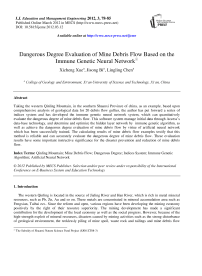Dangerous Degree Evaluation of Mine Debris Flow Based on the Immune Genetic Neural Network
Автор: Xicheng Xue, Jisong Bi, Lingling Chen
Журнал: International Journal of Education and Management Engineering(IJEME) @ijeme
Статья в выпуске: 3 vol.2, 2012 года.
Бесплатный доступ
Taking the western Qinling Mountain, in the southern Shaanxi Province of china, as an example, based upon comprehensive analysis of geological data for 20 debris flow gullies, the author has put forward a series of indices system and has developed the immune genetic neural network system, which can quantitatively evaluate the dangerous degree of mine debris flow. This software system manage initial data through Access’s data-base technology, and determine and optimize the hidden layer network by immune genetic algorithm, as well as achieve the dangerous degree evaluation of mine debris flow by virtue of artificial neural network which has been successfully trained. The calculating results of mine debris flow examples testify that this method is reliable and can accurately evaluate the dangerous degree of mine debris flow. These evaluation results have some important instructive significance for the disaster prevention and reduction of mine debris flow.
Qinling Mountain, Mine Debris Flow, Dangerous Degree, Indices System, Immune Genetic Algorithm, Artificial Neural Network
Короткий адрес: https://sciup.org/15013676
IDR: 15013676
Список литературы Dangerous Degree Evaluation of Mine Debris Flow Based on the Immune Genetic Neural Network
- HOU Enke, HAO Zhucheng, WANG Xiangyang, “The present state of geological environment and restoring strategy in lead-zinc mining areas in Feng Xian,” Nonferrous Metals(Mining), No. 5, pp.12-14, 2001.
- CUI Peng, WEI Fangqiang, XIE Hong etc, “Debris flow and disaster reduction strategies in western china,” Quaternary sciences, Vol. 23, No. 2, pp. 142-151. 2003.
- LIU xilin, TANG Chuan, “The mudslide risk evaluation,” Beijing: Science publisher, 1995.
- WEI yongming, XIE Youyu, WU Yongqiu, “Applications of relativity analysis method and fuzzy synthetical assessment method in classification of dangerous degree of debris flow,” Natural disaster college journal, Vol. 7, No. 2, pp. 109-117, 1998.
- LIU Yongjiang, HU Houtian, BAI Zhiyong, “Mudslide dangerous degree the nerve network method for evaluate,” The geology and Prospecting, Vol. 37, No. 2, pp.84-87, 2001.
- KUANG Lehong, LIU Baochen, YAO Jingcheng, “Research on Regionalization of Debris Flow Risk Degreewith Fuzzy and Extension Method,” Catastrophology, Vol. 21, No.1, pp. 68-72, 2006.
- LIU Jinfeng, OU Guoqiang, “New opinion on debris flows hazard assessment,” The geology disaster and environmental protection, Vol. 15, No. 1, pp. 5-8, 2004.
- XIA Yucheng, CHEN Lianwu, XUE Xi-cheng, “Geoscience information numeralization outline,” Xi’an: Shaanxi Science and Technology Press, 2003.
- Soon Thiam Khu, “Genetic programming and its application in real-time runoff forecasting,” Journal of the American Water Resources Association, Vol. 23, No. 2, pp. 439-450,2001.
- J G Na, “Adaptive optimization of fed-batch culture of yeast by using genetic algorithms,” Bioprocess and biosystems engineering, No. 4, pp. 299-308, 2002.


